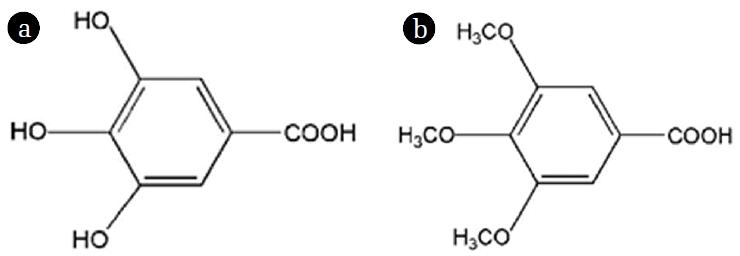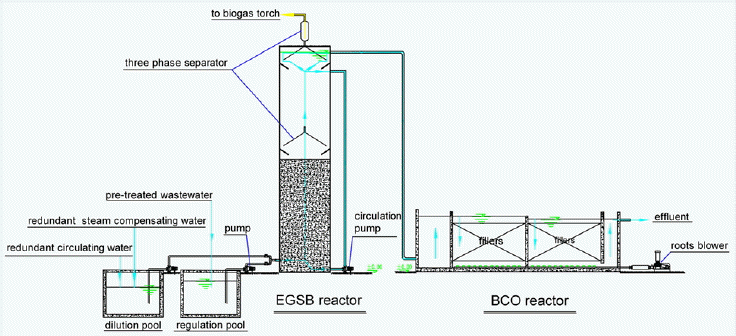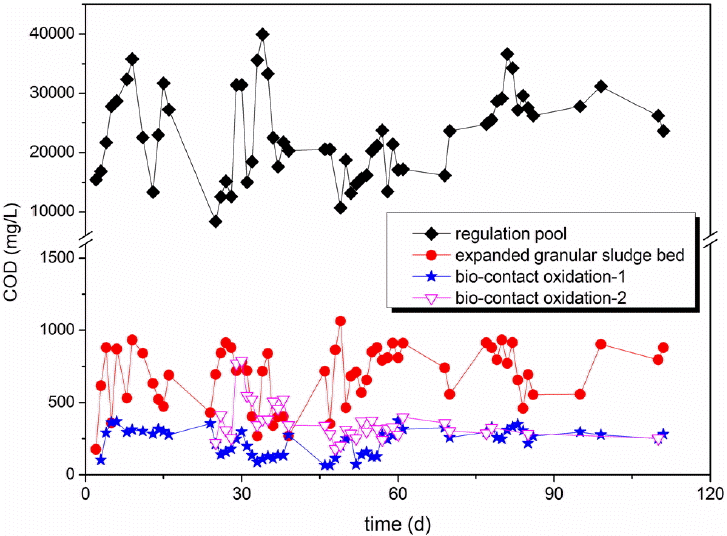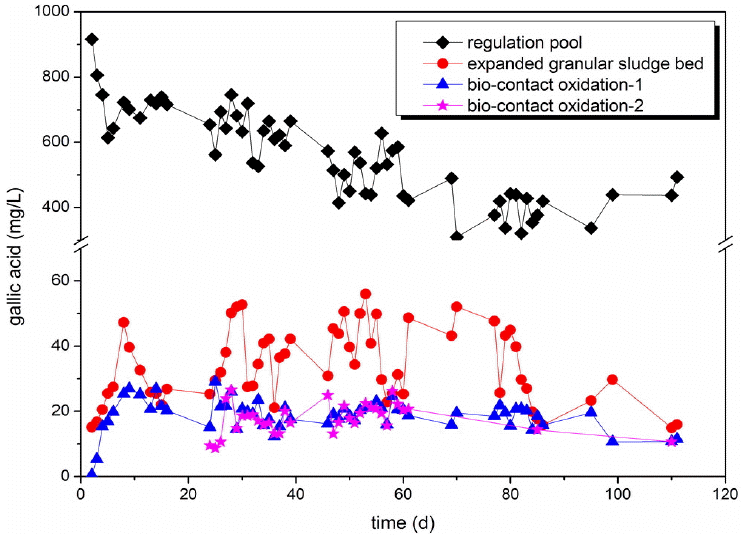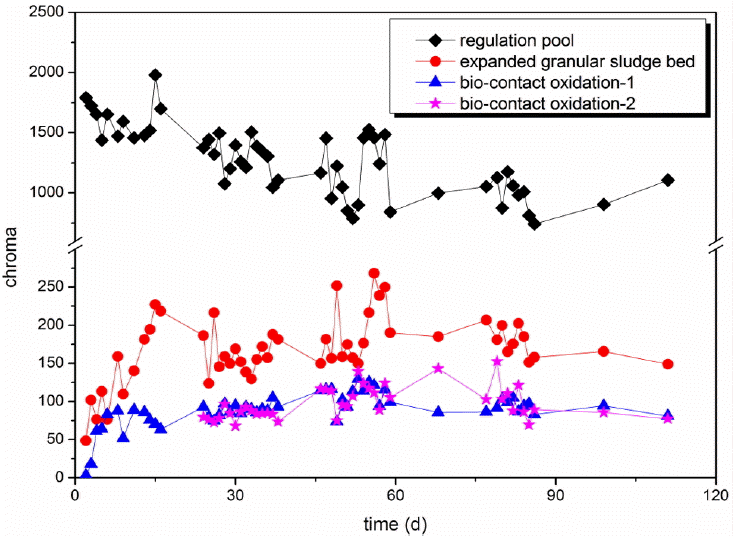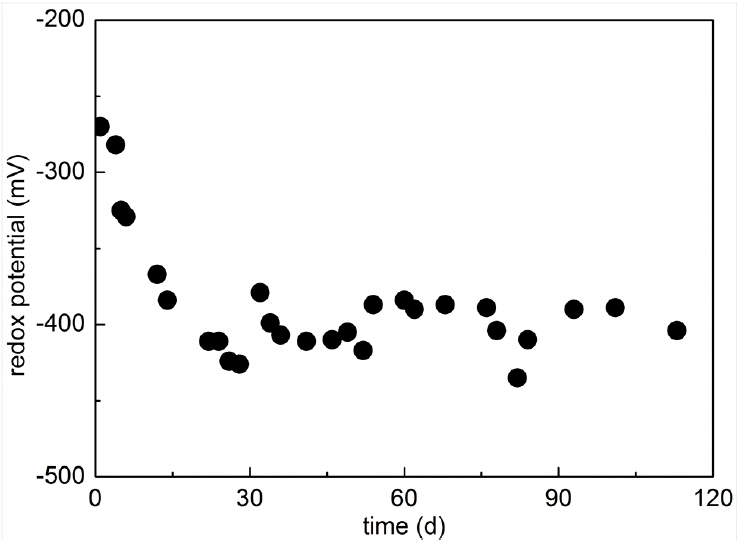1. Introduction
Currently, the treatment of Chinese nutgall processing wastewater is a challenge. The major products of the Chinese nutgall processing industry are gallic acid (Fig. 1(a)) [1], 3, 4, 5-trimethoxybenzoic acid (Fig. 1(b)) [2] and methyl 3, 4, 5-trimethoxybenzoate. Because the gallic acid of high quality are all produced from the alkali hydrolysis process, manufacturers generally choose the alkali hydrolysis process to produce gallic acid [3]. Most organic pollutants contained in the gallic acid wastewater are gallic acid and glucose. Our laboratory had studied the separation of gallic acid from Chinese nutgall processing wastewater by the extraction process; the gallic acid levels remaining in the raffinate measured less than 800 mg/L [4], and the raffinate was collected in the regulation pool after extraction. The raw materials for producing 3, 4, 5-trimethoxybenzoic acid and methyl 3, 4, 5-trimethoxybenzoate were Chinese nutgall and dimethyl sulfate, because methyl 3, 4, 5-trimethoxybenzoate is insoluble in water, and the pollutants contained in the wastewater for producing 3, 4, 5-trimethoxybenzoic acid and methyl 3, 4, 5-trimethoxybenzoate were 3, 4, 5-trimethoxybenzoic acid, glucose, sulfate and a small amount of methanol. After the 3, 4, 5-trimethoxybenzoic acid was recovered by extraction, the 3, 4, 5-trimethoxybenzoic acid level in the raffinate was less than 20 mg/L. Thus, the 3, 4, 5-trimethoxybenzoic acid content was not discussed in this study. The 3, 4, 5-trimethoxybenzoic acid and methyl 3, 4, 5-trimethoxybenzoate wastewater contained a high sulfate concentration, which would inhibit the activity of the methanogenic bacteria and liberate highly toxic hydrogen sulfide in the anaerobic biological process [5]. The 3, 4, 5-trimethoxybenzoic acid and methyl 3, 4, 5-trimethoxybenzoate wastewater were mixed with the gallic acid wastewater raffinate in the regulation pool after being pre-treated by electrodialysis to remove the sulfate.
As environmental regulations have become increasingly stringent, the Chinese nutgall processing industry faces a severe test. Previous studies have focused on the removal of gallic acid and 3, 4, 5-trimethoxybenzoic acid from wastewater [6], but only the removal of gallic acid and 3, 4, 5-trimethoxybenzoic acid was insufficient due to the complex composition of Chinese nutgall processing wastewater. Tannic acid is the main ingredient in the Chinese nutgall, the decomposition of which would generate ten molecules of gallic acid and one molecule of glucose in the ideal case [7]. Few studies have been conducted on biological nutrient removal for Chinese nutgall processing wastewater. Most of the chemical oxygen demand (COD) remaining in the wastewater was glucose, as gallic acid and 3, 4, 5-trimethoxybenzoic acid were isolated. Glucose provides a good carbon source for the growth and metabolism of microorganisms [8, 9]. As the C:N:P ratio in the mixed wastewater was 188:3:1, which closely approximates the optimal C:N:P ratio for anaerobic fermentation [10], the wastewater was appropriate for biological treatment. Additionally, the NaCl concentration in the gallic acid wastewater was approximately 100 g/L. If fed into bioreactors directly, the processing capacity of sludge would be low under high salinity [11]. During Chinese nutgall production, a considerable amount of steam condensation water and residual circulating water are discharged, which could be used as the dilution water for the biological treatment.
An expanded granular sludge bed as an anaerobic process and bio-contact oxidation as an aerobic process were employed in this study. The expanded granular sludge bed has advantages, such as resistance to shock loading [12], less sludge formation [13], and toxicity tolerance [14], which had been applied in the treatment of various organic wastewaters containing high COD content and other complex components [15]. Bio-contact oxidation could maintain a high hydraulic load rate and retain a high biomass concentration. It could also provide resistance to high shock loading [16], promote the growth of microorganisms, and generate less sludge [17].
This study was conducted to investigate the capability of the combined process of the expanded granular sludge bed and the bio-contact oxidation reactors in the removal of COD, gallic acid, total nitrogen, and total phosphorus in Chinese nutgall processing comprehensive wastewater. In addition, changes in the pH of the two reactors and the redox potential in the expanded granular sludge bed were monitored during the operation.
2. Materials and Methods
2.1. Reagents and Analysis
The gallic acid standard was provided by China Pharmaceutical and Biological Products. All reagents used were of analytical reagent grade. The actual Chinese nutgall processing wastewater was obtained from HongJiang Beiya Biotech CO.,LTD. in Huaihua, Hunan province, China.
The COD level [18] and total nitrogen content [19] were assayed with a UV spectrophotometer (UV-1801; Ruili Corp, China). The total phosphorus concentration was analyzed using the molybdate spectrophotometric method [20]. The gallic acid levels were analyzed using high-performance liquid chromatography (HPLC) (Agilent 1100 series; Agilent Technologies, Germany)). The pH was measured by a pH meter using a combined electrode (pHS-3C; INESA Corporation, China). The redox potential was monitored with an acid meter with a combined redox potential electrode (320-S, Mettler Toledo, Switzerland). The inorganic elements were assayed by Inductively Coupled Plasma-Atomic Emission Spectrometry (ICP-AES) (PS-6, Baird Corp, USA).
2.2. The Quantity and Nature of the Wastewater
The quantity and nature of the gallic acid, 3, 4, 5-trimethoxybenzoic acid, and methyl 3, 4, 5-trimethoxy benzoate wastewater are shown in Table 1.
2.3. Character of the Reactors and Schematic Diagram
The industrial-scale expanded granular sludge bed reactor (200 m3 effective volume) was constructed from iron and lagging material (Fig. 2), which had a diameter of 4000 mm, with an effective height of 18000 mm. The bio-contact oxidation reactor (900 m3 effective volume) was constructed from reinforced concrete, which was composed of two independent units connected in parallel. Each independent unit in turn was composed of two independent units connected in series, each of which could be independently controlled. The bio-contact oxidation reactor measured 20000 mm long, 10000 mm wide and 5000 mm in height. The effective height of the bio-contact oxidation reactor was 4500 mm; the safety height was 500 mm; the height of the filler zone was 3000 mm; and the aeration zone was 1000 mm. The material of the filler was polyolefin.
The volume of the anaerobic granular sludge in the expanded granular sludge bed reactor was 60 m3, which was obtained from an anaerobic reactor in a paper mill wastewater treatment facility in Yueyang, Hunan Province, China. The volume of the aerobic sludge was 50 m3, which was acquired from an urban sewage treatment plant in Changsha, Hunan Province, China. The temperatures of the expanded granular sludge bed and the bio-contact oxidation reactors were maintained at 35–40°C and 32–37°C during the operation, respectively, which was conducted under mesophilic conditions.
The hydraulic retention time (HRT) was 8 h for the expanded granular sludge bed and 36 h for the bio-contact oxidation. The reactors were run under a continuous flow. The influent of the expanded granular sludge bed reactor was pre-treated comprehensive wastewater and dilution water, and the dilution water was a mixture of steam condensation water and residual circulating water. The influent of the bio-contact oxidation reactors was the effluent of the expanded granular sludge bed reactor. The rise velocity of the expanded granular sludge bed was maintained at 6–7 m/h by adjusting the reflux ratio. The dissolved oxygen (DO) was adjusted to 2–5 mg/L for the bio-contact oxidation reactors by a Programmable Logic Controller (PLC) (PLC3U-128MR-ES-A; Mitsubishi Electric, Japan). The sludge retention time (SRT) for the expanded granular sludge bed was 10 d, and the bio-contact oxidation was 5 d.
3. Results and Discussion
3.1. Removal of COD
Fig. 3 shows that the COD removal efficiency by the treatment of the combined process of expanded granular sludge bed and bio-contact oxidation was high. Although the variation range of COD in the regulation pool was large, most of the time, the effluent COD of the expanded granular sludge bed was lower than 900 mg/L, and lower than 400 m/L for the bio-contact oxidation. The total removal efficiency of COD by the combined process was higher than 84.853% after 60 d. The points on the effluent curves of the two reactors were close, indicating that the COD removal efficiency of the combined process was effective and stable.
During the run time, the average organic loading rate in the expanded granular sludge bed was 14.218±2.241 kg COD/(m3·d) (Fig. 4), corresponding to 0.898±0.369 kg COD/(m3·d) for bio-contact oxidation-1, and 0.825±0.355 kg COD/(m3·d) for bio-contact oxidation-2. Because most refractory and toxic substances, such as gallic acid and 3, 4, 5-trimethoxybenzoic acid, that are not conducive to the biochemical treatment were separated, the remaining organic matter in the wastewater was mainly glucose. Thus, although the salinity in the regulation pool was high, the organic loading rate of the two reactor remained high.
3.2. Removal of Gallic Acid
The gallic acid concentration in the regulation pool decreased with operation time. The gallic acid was removed by the flocculation pretreatment, which could adsorb part of the gallic acid and other organic matter, and also by degradation by acidifying bacteria, which increased with the operation time in the regulation pool (Fig. 5). The variation range of the gallic acid removal efficiency was large, but during most of the operation, effluent gallic acid levels were less than 50 mg/L in the expanded granular sludge bed and less than 25 mg/L for the bio-contact oxidation. The average total removal efficiency of gallic acid by the combined process was 72.221% after 60 d.
3.3. Removal of Chroma
In the influent, the chroma was composed of the residual gallic acid in the gallic acid wastewater raffinate, 3, 4, 5-trimethoxybenzoic acid in the 3, 4, 5-trimethoxybenzoic acid and methyl 3, 4, 5-trimethoxybenzoate wastewater, and the pigment in the mixed comprehensive wastewater. The effect of 3, 4, 5-trimethoxybenzoic acid was ignored, as its level was very low, so the main factors affecting the effluent chroma were the change in gallic acid and pigment concentrations.
Generally, the chroma is removed by biodegradation and sludge adsorption. In this study, because the sludge produced by the expanded granular sludge bed and bio-contact oxidation was minimal, the chroma was removed primarily by biodegradation. During days 1–11, because the sludge adsorption saturated gradually, and the efficiency of the biological degradation was limited, the effluent chroma in the expanded granular sludge bed and bio-contact oxidation increased gradually (Fig. 6). When the adsorption of sludge was saturated, biodegradation was the main degradation pathway to remove the chroma. During days 11–60, because the quality of influent wastewater was unstable, the variation range of chroma was large. After 60d, the effluent chroma of the combined process was relatively stable: the average effluent chroma of the expanded granular sludge bed was 177.197±26.643, 92.392±9.622 for bio-contact oxidation-1, and 95.092±16.318 for bio-contact oxidation-2. The average total removal efficiency was 43.940% after 60 d. The effluent chroma was still too high, which required further treatment, such as flocculation, adsorption or other further treatment, to make the effluent chroma meet the discharge standard.
3.4. Removal of Total Nitrogen
From day 1 to 30, the effluent total nitrogen increased gradually (Fig. 7); after 30 d, the average effluent total nitrogen of the combined process was 31.029±6.732 mg/L. The range of variation in the effluent total nitrogen of the expanded granular sludge bed reactor was 49.314–75.773 mg/L, while that of the bio-contact oxidation was 20.441–39.939 mg/L. The average total nitrogen removal efficiency was 64.151% after 60 d.
3.5. Removal of Total Phosphorus
Similar to the removal of total nitrogen, the total phosphorus removal capability of the combined process was likewise limited. The effluent total phosphorus of both the expanded granular sludge bed and bio-contact oxidation increased gradually during the initial 49 d and was thereafter maintained in the range of 2.188–2.982 mg/L (Fig. 8). The average total removal efficiency was 39.316%, which demonstrated that the total phosphorus removal capacity of the combined process was poor. The SRT in this research was long, while the biological removal of phosphorus depended mainly on the discharge of adsorbed sludge. A long SRT was not conducive to removing the phosphorus. Therefore, the chemical phosphorus removal process needed to be combined to ensure the effluent total phosphorus complied with the emission standards.
3.6. pH of Influent, Expanded Granular Sludge Bed and Bio-Contact Oxidation Reactors
Because the pH regulation process was run continuously and automatically, the pH of the regulation pool varied in the range of 5.31–7.33, but the effluent pH of the expanded granular sludge bed and bio-contact oxidation was maintained at approximately 7 and 8, respectively. The curve was smooth and the change was small, thus indicating a minimal effect of the influent pH on the expanded granular sludge bed and bio-contact oxidation.
The effluent pH in the expanded granular sludge bed was 6.58–7.29, and bio-contact oxidation was 7.49–8.38, both of which were within the optimal operating range of 6–9. The anaerobic sludge granules appeared to be intact, and the removal efficiencies for COD, gallic acid, chroma, total nitrogen, and total phosphorus were stable, indicating that the expanded granular sludge bed reactor could run normally within this pH range. Similarly, the formed biofilm in the bio-contact oxidation reactor did not slough off, and the removal effect of the pollutants was stable, also indicating that the bio-contact oxidation could run normally and effectively (Fig. 9).
Because the majority of organic matter in the wastewater was glucose, gallic acid and 3, 4, 5-trimethoxybenzoic acid, the change in the pH was due to the degradation of gallic acid, glucose and 3, 4, 5-trimethoxybenzoic acid. The effluent pH of the expanded granular sludge bed was higher than that of the influent. In the anaerobic biochemical reaction, acid-forming bacteria degraded glucose, gallic acid and 3, 4, 5-trimethoxybenzoic acid, generating lactic acid and CO2. Methanogenic bacteria could also degrade glucose, gallic acid, 3, 4, 5-trimethoxybenzoic acid and lactic acid, thereby generating methane and CO2. The presence of lactic acid and CO2 decreased the pH, while the reduction of gallic acid and 3, 4, 5-trimethoxybenzoic acid increased the pH. As the pH in the expanded granular sludge bed was higher than that of the influent, it could be speculated that the effect of the generation of lactic acid was lower than that of gallic acid and 3, 4, 5-trimethoxybenzoic acid degradation. It also indirectly demonstrated that the activity of the acid-forming bacteria was weaker than that of the methanogenic bacteria. In addition, the pH in the effluent of the bio-contact oxidation reactor was higher than in the influent because of the degradation of gallic acid and the blow off of CO2.
3.7. Changes in the Redox Potential in the Expanded Granular Sludge Bed Reactor
During the initial 12 d, the redox potential in the expanded granular sludge bed decreased from −270 mV to −367 mV (Fig. 10), thereafter fluctuating between −367 mV and −435 mV, thus indicating that the microenvironment in the expanded granular sludge bed was stable and suitable for the metabolism of the methanogenic bacteria [21].
4. Conclusions
In this study, we investigated the treatment of Chinese nutgall processing wastewater with an industrial-scale expanded granular sludge bed reactor inoculated with anaerobic granular sludge and a bio-contact oxidation reactor inoculated with polyolefin and aerobic flocculent sludge. The results indicated that the combined process of the expanded granular sludge bed and bio-contact oxidation reactors were feasible for the biological treatment of Chinese nutgall processing wastewater under mesophilic conditions (30–40°C), which is currently not a common practice. An average COD removal efficiency of 87.257% was achieved when the influent COD concentration was 14 251±3 148 mg/L, and the ratio of the wastewater and dilution water was 1:5. The removal efficiencies of gallic acid, chroma, total nitrogen, and total phosphorus were 72.221%, 43.940%, 64.151% and 39.316%, respectively. The effluent pH increased both in the expanded granular sludge bed and in the bio-contact oxidation reactor during the operation. The redox potential in the expanded granular sludge bed reactor varied in the range of −367 mV to −435 mV. To comply with the emission standards, the effluent required additional treatment.







